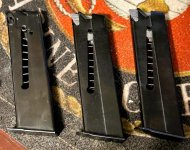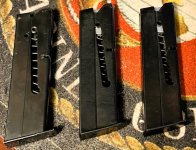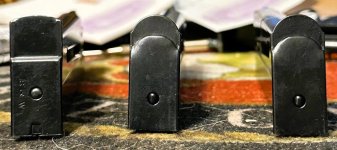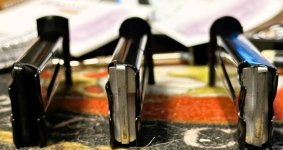Walter Rego
Member
Triple K magazines often get a blanket condemnation for not working reliably.
However, I have bought three of them for guns where original factory magazines were either hard to find or very expensive and made them work. Specifically, they were for a Hi Standard HD Military, a Femaru P37 and a Remington PA51. The trick is to have an original factory mag that is known to be reliable for comparison. The issue was always in the feed lip dimensions, follower angle or both.
What I did was field strip the guns, load several rounds into the original mag and several rounds into the Triple K mag and then insert them into the frame and observe the differences in the feed angle in relation to the feed ramp and barrel throat. The Triple K mags invariably weren't presenting the bullet nose the same as a factory mag, or the feed lips were too loose or too tight. A few minutes with some needle nose pliers that had their jaws protected with some electrical tape and the Triple K mags could be adjusted to work reliably.
Yes, I understand that we shouldn't have to mess with them to get them to work. I assume that the Triple K factory didn't have examples of those guns to work with when they engineered their magazines. But I was able to get those $35 magazines to work for me.
Now regarding the Model 52 mags, given that they need to work with a full wadcutter cartridge, it's going to be no small feat if they are successful. Feeding other autoloading cartridges that have a nice long round nosed jacketed bullet is a lot simpler when you have that bullet to help guide the journey. I have a good supply of factory Model 52 mags and will be awaiting some field reports on the Triple K mags once they are in consumer's hands.
However, I have bought three of them for guns where original factory magazines were either hard to find or very expensive and made them work. Specifically, they were for a Hi Standard HD Military, a Femaru P37 and a Remington PA51. The trick is to have an original factory mag that is known to be reliable for comparison. The issue was always in the feed lip dimensions, follower angle or both.
What I did was field strip the guns, load several rounds into the original mag and several rounds into the Triple K mag and then insert them into the frame and observe the differences in the feed angle in relation to the feed ramp and barrel throat. The Triple K mags invariably weren't presenting the bullet nose the same as a factory mag, or the feed lips were too loose or too tight. A few minutes with some needle nose pliers that had their jaws protected with some electrical tape and the Triple K mags could be adjusted to work reliably.
Yes, I understand that we shouldn't have to mess with them to get them to work. I assume that the Triple K factory didn't have examples of those guns to work with when they engineered their magazines. But I was able to get those $35 magazines to work for me.
Now regarding the Model 52 mags, given that they need to work with a full wadcutter cartridge, it's going to be no small feat if they are successful. Feeding other autoloading cartridges that have a nice long round nosed jacketed bullet is a lot simpler when you have that bullet to help guide the journey. I have a good supply of factory Model 52 mags and will be awaiting some field reports on the Triple K mags once they are in consumer's hands.




